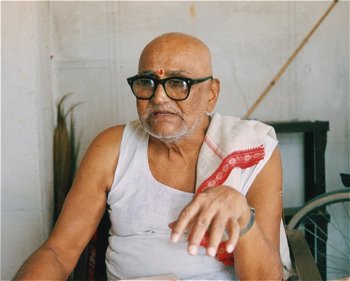Gadiyaram Ramakrishna Sharma
It was a memorable moment to talk and listen to Shri Gadiyaram Ramakrishna Sharma (Sharmaji) recently. He stays at Alampur (in Andhra Pradesh) and had come to Bangalore in connection with the release of his latest book. It is Kannada translation (by Shri Ramachandra Gumaste) of his Telugu book on Vidyaranya, the spiritual preceptor of 14th century who was inspiration, to founders of Vijayanagar Empire.
Earlier, I had consulted Sharmaji only through letters. I gathered his student-experiences in a Gurukula and have included in my book in Kannada on 'Educational Heritage of Karnataka'. Sharmaji had a rare chance of studying under a great Guru, Shatavadhani, Veluri Sivarama Sastri. Veluri came under the influence of Gandhiji. Though he knew English well, he established a Gurukula where he imparted education in ancient lore through traditional way in Sanskrit. Though Sharmaji specialized in grammar and literature, he had love and volition for literature. He acquainted himself in sastras as well. Later he taught himself English, Kannada, Hindi and Urdu. Telugu is his mother tongue and he specialized in classical Telugu-literature and developed liking for epigraphy, archaeology, sculpture and historical research.
R. Seshasastry/Kamat's Potpourri
Picture of Gadiyaram Sri Ramakrishna Sharma
Sharma is great scholar of scriptures, and of Sanskrit and Telugu languages
Born in 1919 in a traditional Telugu Brahmin family, he had the essential shastric background. As his name Gadiyaram indicated, his ancestors must have been time-keepers at Royal - household or religious institution. He fondly remembers his great teacher who was a humanist and quite modern in outlook in spite of his roots in tradition. Perhaps Sharmaji is as active. He fought successfully to save the ancient historical temples of Alampur from submerging when the Shrishaila hydro project came through in Andhra Pradesh.
At 85, he is still quite active, academically or otherwise. He has several scholarly books to his credit, including one on inscriptions of Alampur, other works are on sculpture, Hindu religion, history, and translations of Sanskrit classics in Telugu and Kannada. His new book on 'Vidyaranya' is unique.
This Vidyaranya Royal preceptor or spiritual leader of Sangamas, the founders of Vijayanagara Empire, continues to be a controversial figure. As no biographical details are available, scholars have differed on his original place, residing place and his association with Sangamas. They have tried to establish identity of Madhava, another scholar, General and Royal Preceptor, and failed. Sharmaji has established that, Madhava and Vidyaranya are one and the same. He has also dealt with the deep impact Vidyaranya established, on socio-political life of the period. Being sound scholar in 5 languages, Sharmaji has studied all previous works on the subject and has come to his own conclusions.
He has also shown that in his commentary on Parasara Smriti, Madhava is more narrow and obscurantist than the original Smriti writer Parasara. The thousand year-gap between original writer and medieval commentator is sure to bring in cultural variation, which Sharmaji has brought out fittingly. Society became more and more insular and rigid as time passed.
Sharmaji's knowledge of Sanskrit classics and sastras is encyclopedic. He can quote hundreds of verses out of sheer memory. It is surprising that he has translated Gadayuddha of Ranna, a classic of 10th century in Telugu from Kannada. He feels that old Kannada (Halagannada) is nearer Telugu language.
Every Indian language is rich in literature. But interaction hardly exists except through English, Sanskrit having disappeared. Only scholars like Gadiyaram with high linguistic talents can bring the scholars together who otherwise are insular cocooned in their own 'one language formula' and methodology.
![]()
